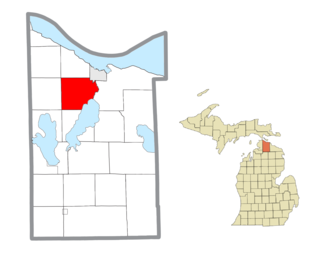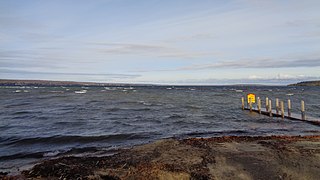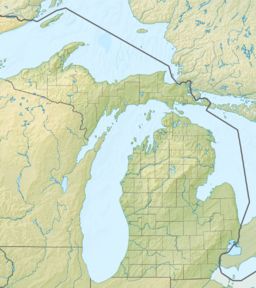
Cheboygan County is a county in the U.S. state of Michigan. As of the 2020 Census, the population was 25,579. The county seat is Cheboygan. The county boundaries were set off in 1840, with land partitioned from Michilimackinac County. The Cheboygan County government was organized and combined with the former Wyandot County in 1853.

Benton Township is a civil township of Cheboygan County in the U.S. state of Michigan. As of the 2010 census, the township population was 3,206.

Indian River is an unincorporated community and census-designated place (CDP) in Cheboygan County in the U.S. state of Michigan. The population was 1,950 at the 2020 census. The CDP is located in Tuscarora Township between Burt Lake and Mullett Lake.

Inverness Township is a civil township of Cheboygan County in the U.S. state of Michigan. The population was 2,261 at the 2010 census. It was named after Inverness in Scotland.

Mullett Township is a civil township of Cheboygan County in the U.S. state of Michigan. The population was 1,312 at the 2010 census. Both the township and Mullett Lake are named for John Mullett, who surveyed much of the area between 1840 and 1843.

Burt Lake is a 17,120 acres (69.3 km2) lake in Cheboygan County in the U.S. state of Michigan. The western shore of the lake is on the boundary with Emmet County. The lake is named after William Austin Burt, who, together with John Mullett, made a federal survey of the area from 1840 to 1843.

Topinabee is an unincorporated community in Cheboygan County in the U.S. state of Michigan. The community is located within Mullet Township along the southwestern shores of Mullett Lake.

Hubbard Lake is a lake in Alcona County in Northern Michigan. The lake covers 8,850 acres (36 km²) and is seven miles (11 km) long (north-south) and two miles (3 km) wide. It has a maximum depth of 85 feet with an average depth of 32.6 feet. The lake spans three townships: Caledonia, Alcona, and Hawes.

Houghton Lake is a lake in Roscommon County, Michigan. The unincorporated community of Prudenville is at the southeastern end of the lake, while the unincorporated communities of Houghton Lake and Houghton Lake Heights are on the southwest and west shores. It is the largest inland lake in the state of Michigan, and one of the largest natural inland lakes in the United States. The lake is approximately 10 miles (16 km) north to south, and about 5+1⁄2 miles (8.9 km) at it widest point. Houghton Lake has c. 30 miles (48 km) of total shoreline and its waters cover 20,044 acres (81.12 km2). It is an extremely popular resort and fishing area year round. Houghton Lake is the site of Tip-Up-Town USA, a large ice fishing and winter sports festival with several events on the frozen waters of the lake itself. Houghton Lake is named after the first state geologist, Douglass Houghton who explored the area. Houghton County, in the Upper Peninsula of Michigan is also named after Douglass Houghton. The name of the lake is pronounced by Michigan citizens as "HOTE'n" (/ˈhoʊʔn̩/).

Higgins Lake is a large recreational and fishing lake in Roscommon County, in the U.S. state of Michigan. The 9,900 acres (4,000 ha) lake is known for its deep, clear waters and is the 10th largest in Michigan with a shoreline of 21 miles (34 km). It is named after Sylvester Higgins, the first chief of the topographical department of the Michigan Geological Survey. It has a maximum width of 4 miles (6.4 km) and a length of 7 miles (11 km) with a maximum depth of 135 feet (41 m). The mean depth is 135 feet (41 m) and the lake contains almost 20 billion cubic feet of water. Its retention time is about 12.5 years. The lake's watershed covers 19,000 acres (7,700 ha). The twin-lobed lake receives half of its water from submerged springs, six percent from incoming streams, and the remainder from direct rainfall and runoff. It drains into Marl Lake by the Cut River which runs into Houghton Lake and eventually to Lake Michigan via the Muskegon River. A mile north of the lake, water flows into the Lake Huron watershed.

Aloha State Park is a public recreation area located six miles (9.7 km) south of Cheboygan in Cheboygan County, Michigan. The state park covers 107 acres (43 ha) on the northeast side of Mullett Lake at the center of the Inland Lakes Waterways.

Burt Lake State Park is a public recreation area covering 406 acres (164 ha) on the south shore of Burt Lake at Indian River in Cheboygan County, Michigan. The state park features over 2000 feet of sandy shoreline, swimming, boating access to the Inland Lakes Waterway, fishing on the Sturgeon River and Burt Lake, and camping facilities.

Walloon Lake is an unincorporated community and census-designated place (CDP) in Charlevoix County in the U.S. state of Michigan. The population of the CDP was 271 at the 2020 census. The community is located within Melrose Township.

The Inland Waterway or Inland Water Route is a 38-mile-long (61 km) series of rivers and lakes in the U.S. state of Michigan. With only a short portage, it forms a navigable route for small craft connecting Lake Huron and Crooked Lake, across the Northern Michigan region. Despite Little Traverse Bay being only 2 miles west of Crooked Lake, the waterway does not connect to it, making Lake Michigan inaccessible through this route.

The Cheboygan River is a short but significant river in the Lake Huron drainage basin of the U.S. state of Michigan.
Little Pigeon River may refer to the following streams in the U.S. state of Michigan:

Indian River in the Lower Peninsula of Michigan is a 3.9-mile-long (6.3 km) waterway in Cheboygan County flowing from Burt Lake at 45°24′37″N84°37′19″W to Mullett Lake at 45°27′05″N84°34′39″W. The unincorporated community of Indian River is named after the river.
Pigeon River may refer to the following streams in the U.S. state of Michigan:
John Mullett (1786–1862) was a prominent surveyor based in Detroit, Michigan in the early 19th century.



















